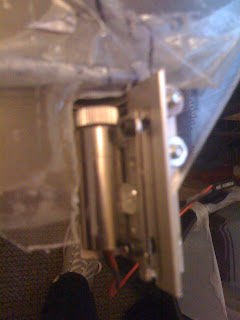I found nuigroup.com one day and they had a bunch of instructions on how to build this stuff. They have awesome forums with tons of discussion on everything multitouch.
Ok so now im building one. Yay. Actually I built one before but it didn't have any image projected onto it. It was basically a big mouse trackpad.
Here's what that looks like. One laser. Total cost about $60 including camera.

There are a few different designs that are popular for multitouch surfaces but they all pretty much work the same. The goal is to somehow get infrared light to reflect off of your fingertips or some other object to be detected, and to pick up these reflections by an infrared camera for processing by some program in the computer. The program you are touching then ends up being projected onto the surface that you touch. Ta da... For more info check out nuigroup.com They have awesome forums with tons of discussion on everything multitouch.
LLP - Laser Light Plane
The design type I am building uses lasers to provide the infrared light. There are 4 infrared lasers on the corners of the screen, with lenses on them that create a wide line instead of a beam. This infrared laser light creates a plane of light across the surface of the screen, where if interrupted by an object like a finger, will reflect down in to the screen and be detected by the camera. Check out www.aixiz.com to buy lasers.
This design choice creates one unique challenge. The lasers have to be able to be precisely aligned to create a perfect plane. If they are misaligned lighting will be inconsistent across the surface. The main surface is a 1/4" piece of acrylic 24"X18". I have chose to cut the laser mounts into the acrylic as this will make the screen more compact. It will also constrict the size of the screen making the mirror potentially smaller and closer, and the whole unit more compact (awesome in my tiny workshop).
The mounts are constructed of two pieces of L shaped 1/16" aluminum stock. One of the pieces is slotted; on the first one I did, the piece attached to the acrylic is slotted. On the rest of the mounts, the piece with the laser is slotted. The V2 mount is less sturdy because of the slot, but it was easier to make, and won't need a wrench to adjust them, and I think it will be sturdy enough. I'm not going to be hammering on them.... I don't think :P
Anyway, here are the pics.
This is the first laser mount. The acrylic is cut with a dremel, it is very rough and took quite a while. Note the nuts holding the bolts to hold the two pieces of the mount together.



These are all the parts for the 4 laser mounts. There are 2 different parts. They are made to be reversible and interchangeable (barring any construction errors on my part).


Markings for 2nd corner cut. Clean cut from coping saw. You can see its blade in the top left. This was the best tool I found for cutting acrylic. Like buttah.


Here are some pics of the new laser mount.
Note that the holes in the piece with the slots are unnecessary.


Assembled mount with laser. Also in the pic is the tool used for adjustment. 3/32" Thorp ball hex driver.


Laser mount V2. No more nuts, aluminum is tapped to accept the screw thread.


 All 4 mounts installed. Bottom left mount is the first one. The holes don't line up for the new mount so I had to keep it. It still works, but it will have to be adjusted with a wrench holding the nut behind it.
All 4 mounts installed. Bottom left mount is the first one. The holes don't line up for the new mount so I had to keep it. It still works, but it will have to be adjusted with a wrench holding the nut behind it.

No comments:
Post a Comment